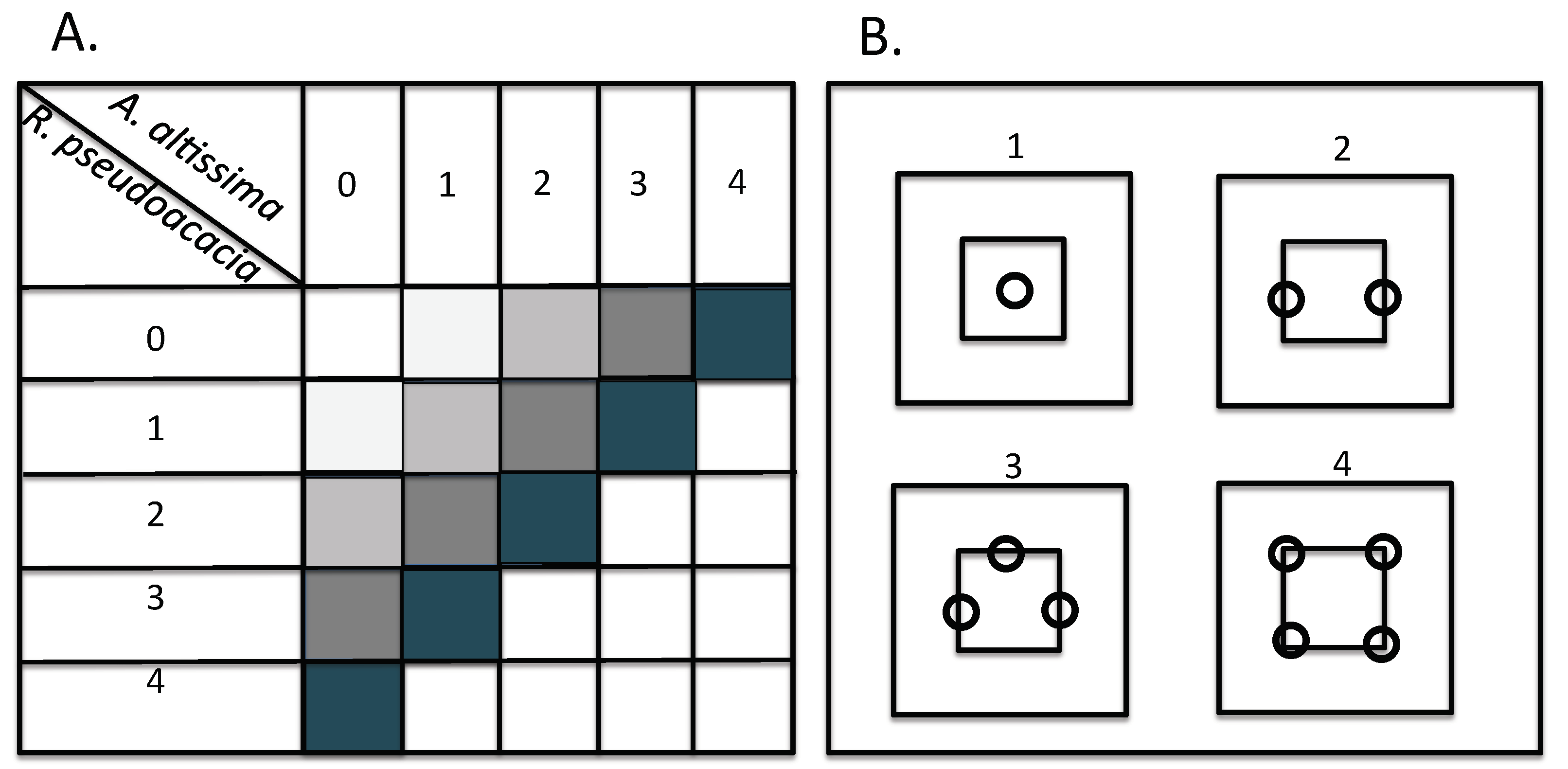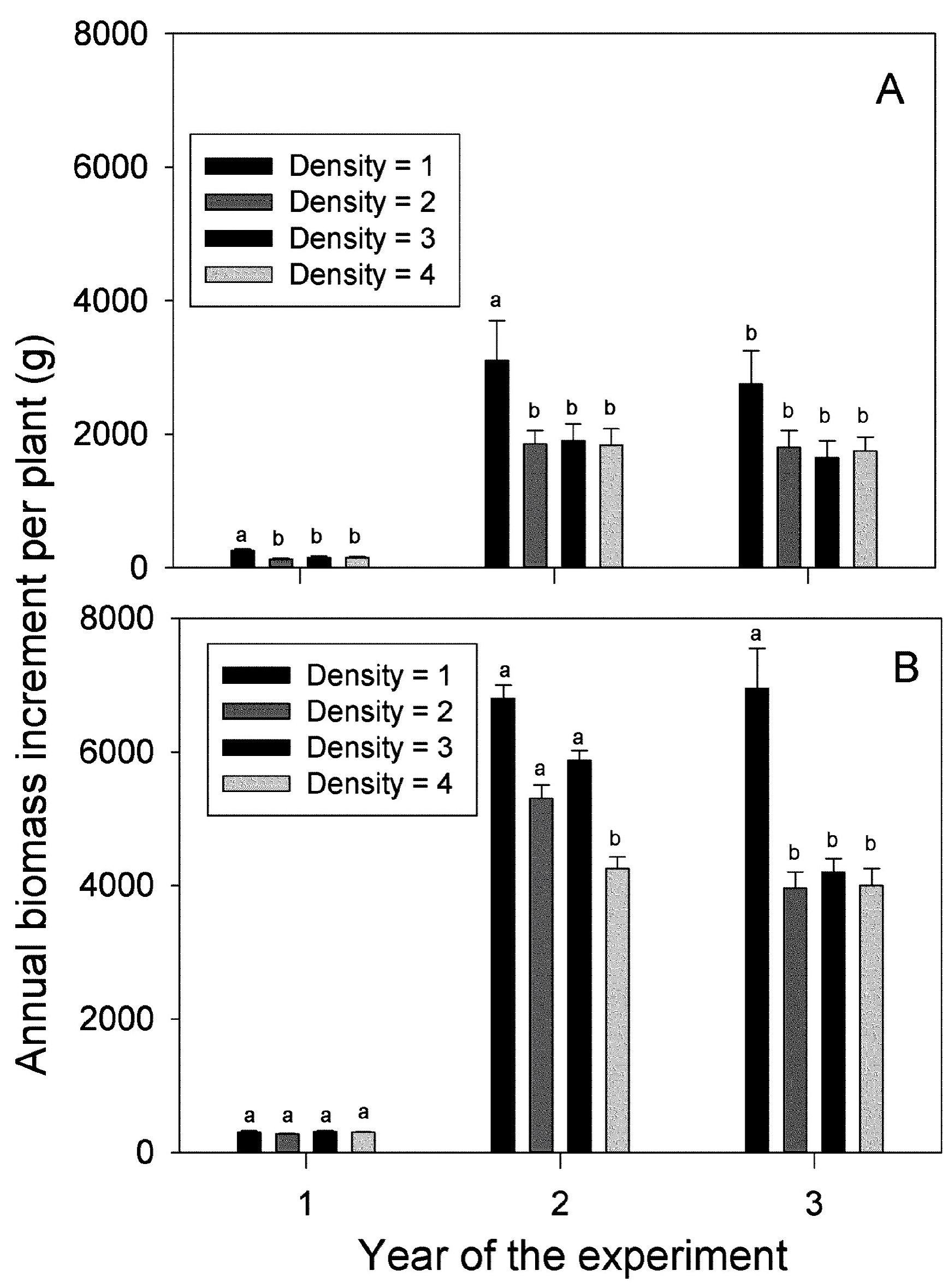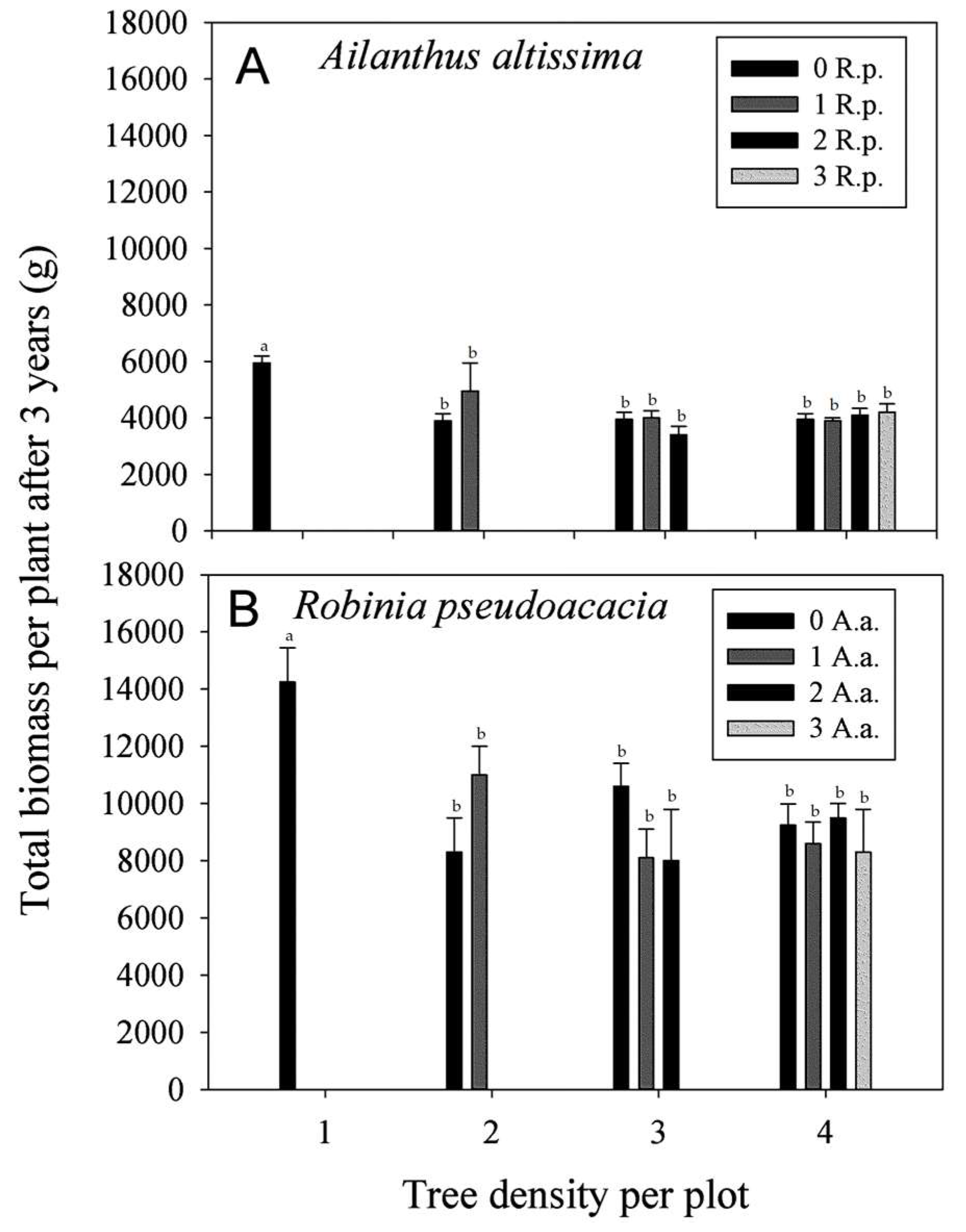Interaction between Ailanthus altissima and Native Robinia pseudoacacia in Early Succession: Implications for Forest Management
Abstract
1. Introduction
2. Materials and Methods
2.1. Study Species and Site Description
2.2. Experimental Design
2.3. Dimension Analysis, Competition Indices and Data Analysis
3. Results
3.1. Growth Patterns and Dimension Equations
3.2. Intraspecific Competition
3.3. Interspecific Facilitation or Competition
3.4. Competition Indices
4. Discussion
4.1. Is the Interaction between Species Competition, Facilitation or Coexistence?
4.2. Does the Interaction between Species Change from Seedling to Sapling?
4.3. What Are the Forest Management Implications of This Research?
5. Conclusions
Acknowledgments
Author Contributions
Conflicts of Interest
References
- Stinson, K.A.; Campbell, S.A.; Powell, J.R.; Wolfe, B.E.; Callaway, R.M.; Thelen, G.C.; Hallett, S.G.; Prati, D.; Klironomos, J.N. Invasive plant suppresses the growth of native tree seedlings by disrupting belowground mutualisms. PLoS Biol. 2006, 4, 727–731. [Google Scholar] [CrossRef] [PubMed]
- Alvarez, M.E.; Cushman, J.H. Community-level consquences of a plant invasion: Effects on three habitats in coastal California. Ecol. Appl. 2002, 12, 1434–1444. [Google Scholar] [CrossRef]
- Kohli, R.; Batish, D.; Singh, H.; Dogra, K. Status, invasiveness and environmental threats of three tropical American invasive weeds (Parthenium hysterophorus, Ageratum conyzoides, Lantana camara) in India. Biol. Invasions 2006, 8, 1501–1510. [Google Scholar] [CrossRef]
- Gray, A. Monitoring and assessment of regional impacts from nonnative invasive plants in forests of the Pacific Coast, United States. In Invasive Plants and Forest Ecosystems; Kohli, R.K., Jose, S., Singh, H.P., Batish, D.R., Eds.; CRC Press: Boca Raton, FL, USA, 2008; pp. 217–235. [Google Scholar]
- Rodrigues, R.R.; Pineda, R.P.; Barney, J.N.; Nilsen, E.T.; Barrett, J.E.; Williams, M.A. Plant invasions associated with change in root-zone microbial community structure and diversity. PLoS ONE 2014, 10, e0141424. [Google Scholar] [CrossRef] [PubMed]
- Meekins, J.F.; McCarthy, B.C. Competitive ability of Alliaria petiolata (Garlic Mustard, Brassicaceae), an invasive, nonindigenous forest herb. Int. J. Plant Sci. 1999, 160, 743–752. [Google Scholar] [CrossRef]
- Belote, R.T.; Weltzin, J. Interactions between two co-dominant, invasive plants in the understory of a temperate deciduous forest. Biol. Invasions 2006, 8, 1629–1641. [Google Scholar] [CrossRef]
- Eckert, C.G.; Manicacci, D.; Barrett, S.C.H. Genetic drift and founder effect in native versus introduced populations of an invading plant, Lythrum salicaria (Lythraceae). Evolution 1996, 50, 1512–1519. [Google Scholar] [CrossRef] [PubMed]
- Gómez-Aparicio, L.; Canham, C.D. Neighbourhood analyses of the allelopathic effects of the invasive tree Ailanthus altissima in temperate forests. J. Ecol. 2008, 96, 447–458. [Google Scholar] [CrossRef]
- Seabloom, E.W.; Harpole, W.S.; Reichman, O.J.; Tilman, D. Invasion, competitive dominance, and resource use by exotic and native California grassland species. Proc. Natl. Acad. Sci. USA 2003, 100, 13384–13389. [Google Scholar] [CrossRef] [PubMed]
- Luo, Y.J.; Guo, W.H.; Yuan, Y.F.; Liu, J.; Du, N.; Wang, R.Q. Increased nitrogen deposition alleviated the competitive effects of of the introduced invasive plant Robinia pseudoacacia on the native tree Quercus acutissima. Plant Soil 2014, 385, 63–75. [Google Scholar] [CrossRef]
- Sun, Y.; Muller-Schaerer, H.; Maron, J.L.; Schaffner, U. Biogeographic effects on early establishment of an invasive alien plant. Am. J. Bot. 2015, 102, 621–625. [Google Scholar] [CrossRef] [PubMed]
- Weigelt, A.; Jolliffe, P. Indices of plant competition. J. Ecol. 2003, 91, 707–720. [Google Scholar] [CrossRef]
- Harper, J.L.; Clatworthy, J.N.; McNaughton, I.H.; Sagar, G.R. The evolution and ecology of closely related species living in the same area. Evolution 1961, 15, 209–227. [Google Scholar] [CrossRef]
- Rodriguez, L. Can invasive species facilitate native species? Evidence of how, when, and why these impacts occur. Biol. Invasions 2006, 8, 927–939. [Google Scholar] [CrossRef]
- Holmgren, M.; Scheffer, M.; Huston, M.A. The interplay of facilitation and competition in plant communities. Ecology 1997, 78, 1966–1975. [Google Scholar] [CrossRef]
- Sthultz, C.M.; Gehring, C.A.; Whitham, T.G. Shifts from competition to facilitation between a foundation tree and a pioneer shrub across spatial and temporal scales in a semiarid woodland. New Phytol. 2007, 173, 135–145. [Google Scholar] [CrossRef] [PubMed]
- Call, L.J.; Nilsen, E.T. Analysis of spatial patterns and spatial association between the invasive tree-of-heaven (Ailanthus altissima) and the native black locust (Robinia pseudoacacia). Am. Midl. Nat. 2003, 150, 1–14. [Google Scholar] [CrossRef]
- Feret, P.P. Notes: Early flowering in Ailanthus. For. Sci. 1973, 19, 237–239. [Google Scholar]
- Knapp, L.B.; Canham, C.D. Invasion of an old-growth forest in New York by Ailanthus altissima: Sapling growth and recruitment in canopy gaps. J. Torrey Bot. Soc. 2000, 127, 307–315. [Google Scholar] [CrossRef]
- Castro-Díez, P.; González-Muñoz, N.; Alonso, A.; Gallardo, A.; Poorter, L. Effects of exotic invasive trees on nitrogen cycling: A case study in central Spain. Biol. Invasions 2008, 11, 1973–1986. [Google Scholar] [CrossRef]
- Radtke, A.; Ambra, S.; Zerbe, S.; Tonon, G.; Fontana, V.; Ammer, C. Traditional coppice forest management drives the invasion of Ailanthus altissima and Robinia pseudoacacia into deciduous forests. For. Ecol. Manag. 2013, 291, 308–317. [Google Scholar] [CrossRef]
- Medina-Villar, S.; Rodríguez-Echeverría, S.; Lorenzo, P.; Alonso, A.; Perez-Corona, E.; Castro-Díez, P. Impacts of the alien trees Ailanthus altissima (Mill.) Swingle and Robinia pseudoacacia L. on soil nutrients and microbial communities. Soil Biol. Biochem. 2016, 96, 65–73. [Google Scholar] [CrossRef]
- Boring, L.; Swank, W. The role of black locust (Robinia pseudoacacia) in forest succession. J. Ecol. 1984, 72, 749–766. [Google Scholar] [CrossRef]
- Kou, M.; Garcia-Fayos, P.; Hu, S.; Jiao, J. The effect of Robinia pseudoacacia afforestation on soil and vegetation properties in the Loess Plateau (China): A chronosequence approach. For. Ecol. Manag. 2016, 375, 146–158. [Google Scholar] [CrossRef]
- Von Holle, B.; Joseph, K.; Largay, E.; Lohnes, R. Facilitations between the introduced nitrogen-fixing tree, Robinia pseudoacacia, and nonnative plant species in the glacial outwash upland ecosystem of Cape Cod, MA. Biodivers. Conserv. 2006, 15, 2197–2215. [Google Scholar] [CrossRef]
- Inouye, B.D. Response surface experimental designs for investigating interspecific competition. Ecology 2001, 82, 2696–2706. [Google Scholar] [CrossRef]
- Freckleton, R.; Watkinson, A.R. The mis-measurement of plant competition. Funct. Ecol. 1999, 13, 285–287. [Google Scholar]
- Thomas, S.; Weiner, J. Including competitive asymmetry in measures of local interference in plant populations. Oecologia 1989, 80, 349–355. [Google Scholar] [CrossRef] [PubMed]
- Ramseier, D.; Weiner, J. Competitive effect is a linear function of neighbour biomass in experimental populations of Kochia scoparia. J. Ecol. 1989, 94, 305–309. [Google Scholar] [CrossRef]
- Spitters, C.T.J. An alternative approach to analysis of mixed cropping experiments. I. Estimation of competitive effects. Neth. J. Agric. Sci. 1983, 31, 1–11. [Google Scholar]
- Firbank, L.G.; Watkinson, A.R. On the analysis of competition within two-species mixtures of plants. J. Appl. Ecol. 1985, 22, 503–517. [Google Scholar] [CrossRef]
- Armas, C.; Ordiales, R.; Pugnaire, F.I. Measuring plant interactions: A new comparative index. Ecology 2004, 85, 2682–2686. [Google Scholar] [CrossRef]
- Efron, B.; Tibshirani, R. Statistical data analysis in the computer age. Science 1991, 253, 390–395. [Google Scholar] [CrossRef] [PubMed]
- Westbrooks, R.G. New approaches for early detection and rapid response to invasive plants in the United States. Weed Technol. 2004, 18, 1468–1471. [Google Scholar] [CrossRef]
- Vilà, M.; Weiner, J. Are invasive plant species better competitors than native plant species? Evidence from pair-wise experiments. Oikos 2004, 105, 229–238. [Google Scholar] [CrossRef]
- Tecco, P.A.; Díaz, S.; Cabido, M.; Urcelay, C. Functional traits of alien plants across contrasting climatic and land-use regimes: Do aliens join the locals or try harder than them? J. Ecol. 2010, 98, 17–27. [Google Scholar] [CrossRef]
- Gioria, M.; Osborne, B.A. Resource competition in plant invasions: Emerging patterns and research needs. Front. Plant Sci. 2014, 5, 501. [Google Scholar] [CrossRef] [PubMed]
- Siemann, E.; Rogers, W.E. Changes in light and nitrogen availability under pioneer trees may indirectly facilitate tree invasions of grasslands. J. Ecol. 2003, 91, 923–931. [Google Scholar] [CrossRef]
- Kueffer, C.; Schumacher, E.; Fleischmann, K.; Edwards, P.J.; Dietz, H. Strong belowground competition shapes tree regeneration in invasive Cinnamomum verum forests. J. Ecol. 2007, 95, 273–282. [Google Scholar] [CrossRef]
- Hejda, M.; Pyšek, P.; Jarošík, V. Impact of invasive plants on the species richness, diversity and composition of invaded communities. J. Ecol. 2009, 97, 393–403. [Google Scholar] [CrossRef]
- Strayer, D.L.; Eviner, V.T.; Jeschke, J.M.; Pace, M.L. Understanding the long-term effects of species invasions. Trends Ecol. Evol. 2006, 21, 645–651. [Google Scholar] [CrossRef] [PubMed]
- Atwood, T.B.; Wiegner, T.N.; Turner, P.; MacKenzie, R.A. Potential effects of an invasive nitrogen-fixing tree on a Hawaiian stream food web. Pac. Sci. 2010, 64, 367–379. [Google Scholar] [CrossRef]
- Vilà, M.; Espinar, J.L.; Hejda, M.; Hulme, P.E.; Jarošík, V.; Maron, J.L.; Pergl, J.; Schaffner, U.; Sun, Y.; Pyšek, P. Ecological impacts of invasive alien plants: A meta-analysis of their effects on species, communities and ecosystems. Ecol. Lett. 2011, 14, 702–708. [Google Scholar] [CrossRef] [PubMed]
- Tielbörger, K.; Kadmon, R. Indirect effects in a desert plant community: Is competition among annuals more intense under shrub canopies? Plant Ecol. 2000, 150, 53–63. [Google Scholar] [CrossRef]
- Bao, Z.; Nilsen, E.T. Interactions between seedlings of the invasive tree Ailanthus altissima and the native tree Robinia pseudoacacia under low nutrient conditions. J. Plant Interact. 2015, 10, 173–184. [Google Scholar] [CrossRef]
- Call, L.J.; Nilsen, E.T. Analysis of the interaction between the invasive tree-of-heaven (Ailanthus altissima) and the native black locust (Robinia pseudoacacia). Plant Ecol. 2005, 176, 275–285. [Google Scholar] [CrossRef]
- Batish, D.; Lavanya, K.; Singh, H.; Kohli, R. Phenolic allelochemicals released by Chenopodium murale affect the growth, nodulation and macromolecule content in chickpea and pea. Plant Growth Regul. 2007, 51, 119–128. [Google Scholar] [CrossRef]
- Phillips, D.L.; Shure, D.J. Patch-size effects on early succession in southern Appalachian forests. Ecology 1990, 71, 204–212. [Google Scholar] [CrossRef]
- Benesperi, R.; Giuliani, C.; Zanetti, S.; Gennai, M.; Lippi, M.M.; Guidi, T.; Nascimbene, J.; Foggi, B. Forest plant diversity is threatened by Robinia pseudoacacia (black locust) invasion. Biodivers. Conserv. 2012, 21, 3555–3568. [Google Scholar] [CrossRef]
- Kowarik, I.; Säumel, I. Biological flora of Central Europe: Ailanthus altissima (Mill.) Swingle. Perspect. Plant Ecol. Evol. Syst. 2007, 8, 207–237. [Google Scholar] [CrossRef]
- Rebbeck, J.; Hutchinson, T.; Iverson, L.; Yaussy, D.; Fox, T. Distribution and demographics of Ailanthus altissima in an oak forest landscape managed with timber harvesting and prescribed fire. For. Ecol. Manag. 2017, 401, 233–241. [Google Scholar] [CrossRef]
- Walker, G.A.; Gaertner, M.; Robertson, M.P.; Richardson, D.M. The prognosis for Ailanthus altissima (Simaroubaceae; tree of heaven) as an invasive species in South Africa; insights from its performance elsewhere in the world. S. Afr. J. Bot. 2017, 112, 283–289. [Google Scholar] [CrossRef]
- Constán-Navaa, S.; Boneta, A.; Pastora, E.; Lledóa, M.J. Long-term control of the invasive tree Ailanthus altissima: Insights from Mediterranean protected forests. For. Ecol. Manag. 2010, 260, 1058–1064. [Google Scholar] [CrossRef]
- Wickert, K.L.; O’Neal, E.S.; Davis, D.D.; Kasson, M.T. Seed production, viability, and reproductive limits of the invasive Ailanthus altissima (Tree-of-Heaven) within invaded environments. Forests 2017, 8, 226. [Google Scholar] [CrossRef]




| Biomass Estimation Equation and Adjusted R2 | ||
|---|---|---|
| aAilanthus altissima | Robinia pseudoacacia | |
| 2011 | b Biomass (g) = (−4.94247 + 1.974 × Height (m) + 7.266 × Diameter (cm) + 0.74 × (Height − 1.4963) × (Diameter − 2.5354))2 R2 = 0.951 | Biomass (g) = Exp (2.5812 + 1.6176 × Diameter (cm) − 0.1 × Diameter2) R2 = 0.947 |
| 2012 | ||
| 2013 | Biomass (g) = (−10.43578 + 1.952572 × Height (m) + 9.263966 × Diameter (cm) + 0.795541 × (Height−2.37) × (Diameter − 3.7924)) 2 R2 = 0.976 | Biomass (g) = −5847.114 − 361.3571 × Height (m) − 2052.2315 × Diameter (cm) + 287.6451 × (Height − 3.358) × (Diameter − 5.871) R2 = 0.966 |
| Fixed Effect | a Num DF | Den DF | F Value | p Value |
|---|---|---|---|---|
| bA. altissima | ||||
| c Density | 2 | 85 | 0.43 | 0.6546 |
| d % of R. pseudoacacia | 5 | 85 | 0.28 | 0.9235 |
| Density by % of R. pseudoacacia | 10 | 85 | 0.40 | 0.5300 |
| Year | 2 | 186 | 118.48 | <0.0001 |
| R. pseudoacacia | ||||
| Density | 2 | 86 | 0.94 | 0.3942 |
| % of A. altissima | 5 | 86 | 0.93 | 0.4665 |
| Density by % of A. altissima | 10 | 86 | 0.67 | 0.4170 |
| Year | 2 | 187 | 152.39 | <0.0001 |
| Competition Indices | ||||||
|---|---|---|---|---|---|---|
| A. altissima | R. pseudoacacia | |||||
| Year | a Baa | Baarp | Saa | Brp | Brpaa | Srp |
| 1 | b −17.23 | −3.54 | 0.20 | −10.38 | −63.99 | 6.61 |
| 2 | −176.31 | −70.24 | 0.39 | −634.31 | −582.31 | 0.92 |
| 3 | −193.28 | −174.14 | 0.90 | −256.95 | −598.27 | 2.33 |
| Density (No. Tree Per Plot) | ||||||
|---|---|---|---|---|---|---|
| A. altissima | R. pseudoacacia | |||||
| a 2 | 3 | 4 | 2 | 3 | 4 | |
| Year 1 | b −0.175 A c | −0.070 B | −0.107 AB | −0.077 A | −0.065 A | −0.095 A |
| Year 2 | −0.096 A | −0.179 A | −0.171 A | −0.149 A | −0.177 A | −0.131 A |
| Year 3 | 0.013 AB | −0.069 B | −0.089 B | −0.223 A | −0.255 A | −0.221 A |
| Results for A. altissima | |||||||||
| 2A a,b | 1A1R | 3A | 2A1R | 1A2R | 4A | 3A1R | 2A2R | 1A3R | |
| Year 1 | −0.296 C c | −0.095 AB | 0.004 A | −0.213 BC | 0.018 A | −0.106 ABC | −0.084 AB | −0.084 AB | −0.153 ABC |
| Year 2 | −0.195 AB | −0.029 A | −0.140 AB | −0.193 AB | −0.209 AB | −0.120 AB | −0.165 AB | −0.144 AB | −0.254 B |
| Year 3 | −0.047 AB | −0.021 A | −0.002 A | −0.069 AB | −0.151 AB | 0.010 A | −0.265 B | −0.052 AB | −0.050 AB |
| Results for R. pseudoacacia | |||||||||
| 2R | 1R1A | 3R | 1R2A | 2R1A | 4R | 1R3A | 2R2A | 3R1A | |
| Year 1 | −0.233 AB | 0.034 A | 0.002 AB | −0.216 AB | 0.039 AB | 0.007 AB | −0.253 B | −0.154 AB | 0.021 AB |
| Year 2 | −0.233 A | −0.090 A | −0.121 A | −0.285 A | −0.110 A | −0.094 A | −0.236 A | −0.168 A | −0.045 A |
| Year 3 | −0.321 A | −0.153 A | −0.262 A | −0.361 A | −0.114 A | −0.135 A | −0.251 A | −0.304 A | −0.194 A |
© 2018 by the authors. Licensee MDPI, Basel, Switzerland. This article is an open access article distributed under the terms and conditions of the Creative Commons Attribution (CC BY) license (http://creativecommons.org/licenses/by/4.0/).
Share and Cite
Nilsen, E.T.; Huebner, C.D.; Carr, D.E.; Bao, Z. Interaction between Ailanthus altissima and Native Robinia pseudoacacia in Early Succession: Implications for Forest Management. Forests 2018, 9, 221. https://doi.org/10.3390/f9040221
Nilsen ET, Huebner CD, Carr DE, Bao Z. Interaction between Ailanthus altissima and Native Robinia pseudoacacia in Early Succession: Implications for Forest Management. Forests. 2018; 9(4):221. https://doi.org/10.3390/f9040221
Chicago/Turabian StyleNilsen, Erik T., Cynthia D. Huebner, David E. Carr, and Zhe Bao. 2018. "Interaction between Ailanthus altissima and Native Robinia pseudoacacia in Early Succession: Implications for Forest Management" Forests 9, no. 4: 221. https://doi.org/10.3390/f9040221
APA StyleNilsen, E. T., Huebner, C. D., Carr, D. E., & Bao, Z. (2018). Interaction between Ailanthus altissima and Native Robinia pseudoacacia in Early Succession: Implications for Forest Management. Forests, 9(4), 221. https://doi.org/10.3390/f9040221





